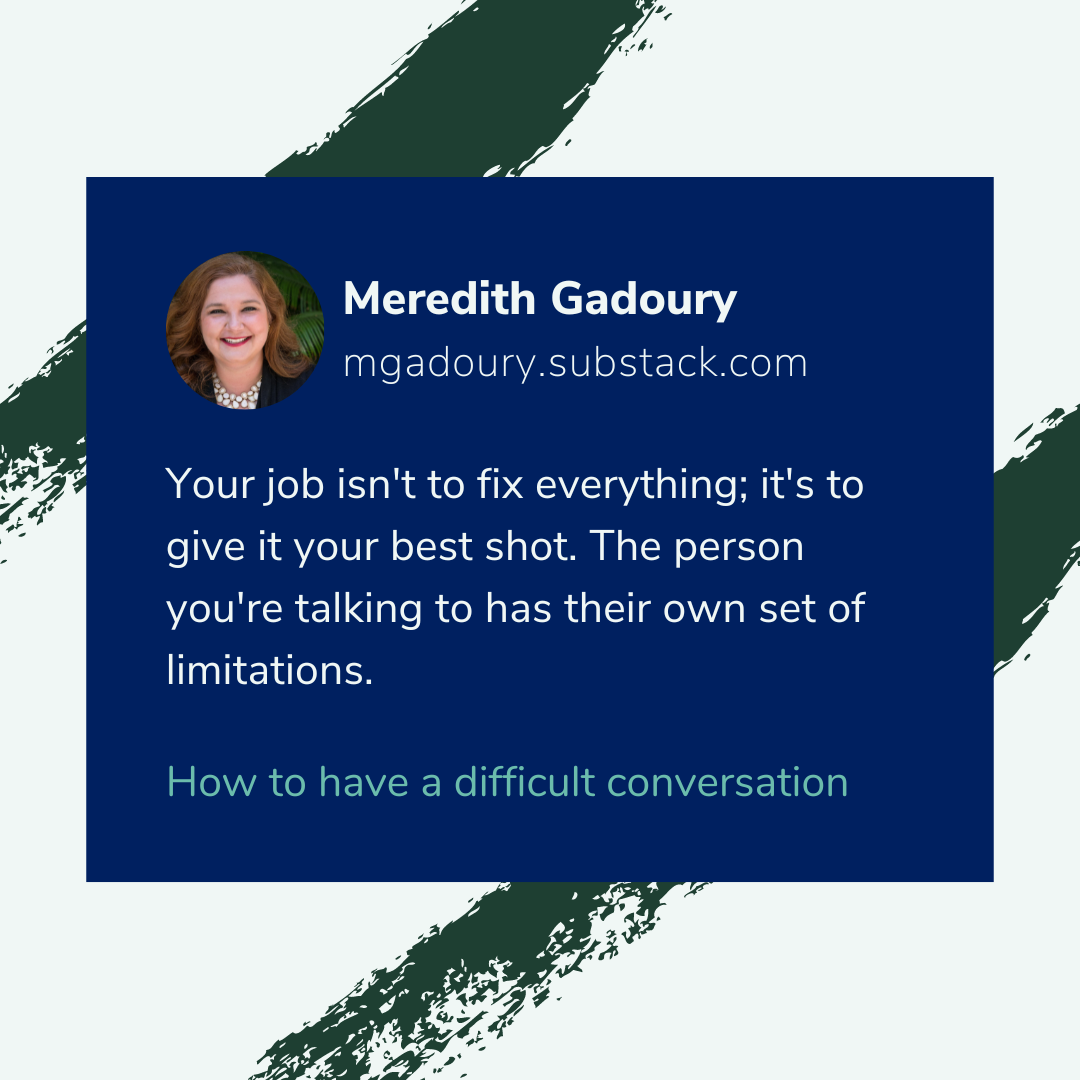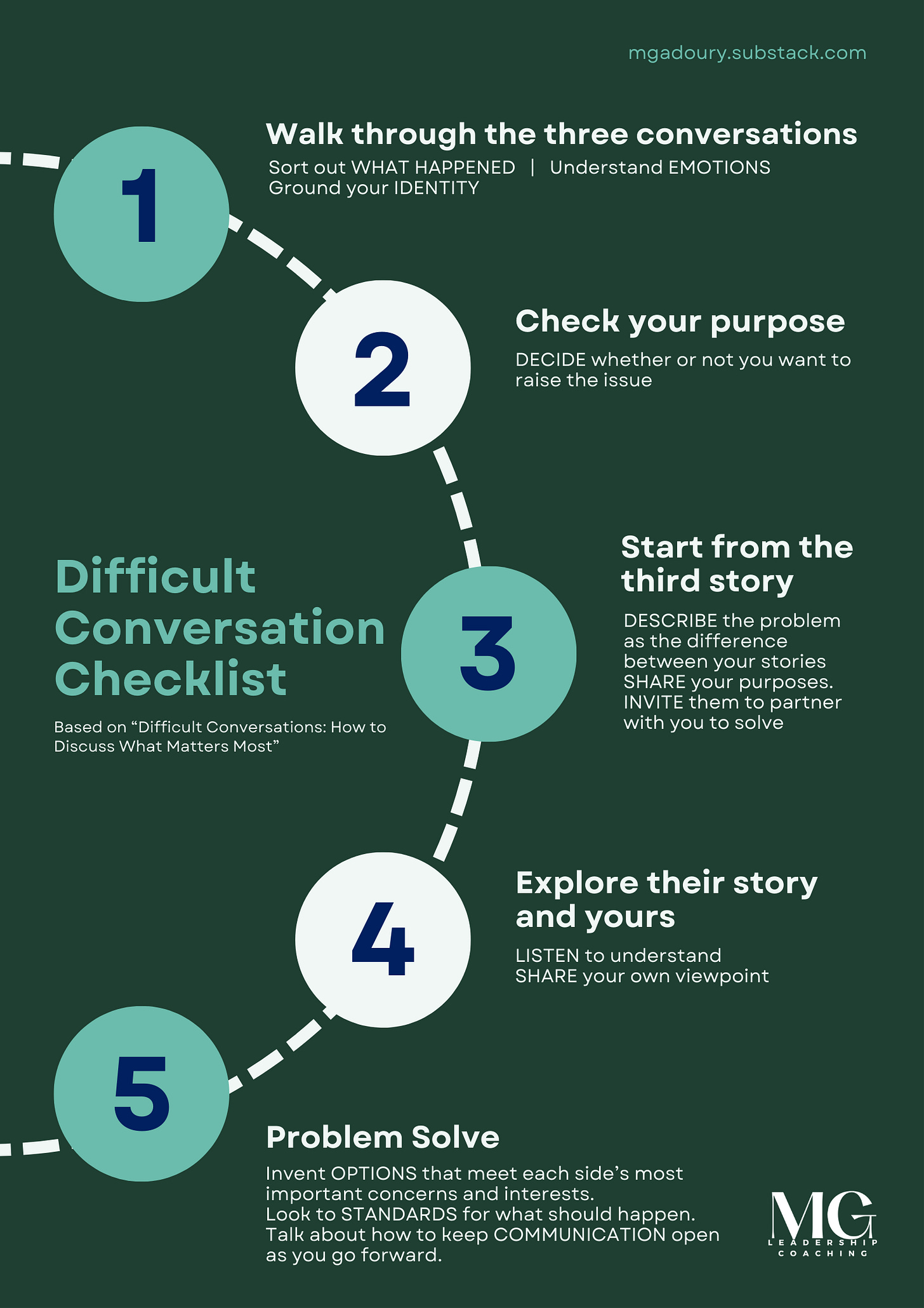Pre-newsletter heads-up! In case you missed last week's edition, I've been shaking things up a bit lately with a four-part exploration into the realm of difficult conversations. Part 1 delved into "What makes difficult conversations so tricky?" while Part 2 unravelled the mystery of "How do we avoid those conversation pitfalls?" Now, get ready for Part 3, where I'll show you a step-by-step guide for your next difficult conversation. Finally, Part 4 will be a "Top 10" rundown on handling difficult conversations. Learn more on this topic by checking: Difficult Conversations: How to Discuss What Matters Most.
Quick recap, plus step 1: Prepare by walking through the three conversations
If the term "three conversations" sounds like gibberish, do yourself a favor and catch up on Part 1 and Part 2 of this series. The first step in any difficult conversation is to prepare. To accomplish this, consider the three conversations:
Unravel “what happened”
Where does your story come from? What information, past experiences, or “life rules” influence your perception of the situation? What do you imagine their story is?
What impact has this situation had on you? What might their intention have been?
What have each of you contributed to the problem?
Decode your emotions
Explore the full range of emotions this problem causes you to experience. Remember, humans are complex and it’s mostly likely several different emotions!
Anchor your identity
What's on the line for your identity? Figure out what you need to embrace for a solid footing.
Once you've successfully navigated the three discussions, you're ready for Step 2!
Step 2: Assess Your Purpose and Decide to Speak Up or Not
After maneuvering through those three convos – getting a grip on your feelings, identifying perception gaps, and sorting out any identity hiccups – you might discover that starting the conversation isn't the best move.
Wondering when to hold back? Here are three questions to run by yourself:
Is the conflict within us? Reflecting on truth, intention, and contribution might reveal the issue resides in your head, making it unnecessary to discuss with someone else.
Is there a more effective way to address it? Could taking action (or refraining from it) serve the issue better than talking about it?
Do you have a purpose that makes sense? If your goal is to change someone, vent, or unleash a tirade, you're not in the right mindset for a challenging conversation. Revisit the three convos and aim for curiosity and understanding of the other person's story and truth.
If you decide to push forward with the difficult conversation, stay focused on understanding their story, expressing your views and feelings, and jointly tackling the problem. Remember, your job isn't to fix everything; it's to give it your best shot. The person you're talking to has their own set of limitations.
Step 3: Start from the third story
Starting a difficult conversation often leads to foot-in-mouth syndrome because we tend to launch right from our own tale and viewpoint, which in turn triggers the identity conversation right from the start.
Instead, we want to try a different approach starting from the third story. But what’s that? Recall part 1 when I wrote about truth - there is your truth, and their truth, both are valid. The third story is the observer’s perspective. Beginning from the third story might sound like this:
“My sense is that we're seeing this situation differently. I want to share my perspective and hear yours.”
Next, you want to extend an invitation to the difficult conversation. Don't ambush; describe why it matters and suggest you tackle the solution together. If now's not the best time, persist and nail down a better time.
Step 4: Explore their story and yours
Now, let's dive into the heart of the difficult conversation: the chance for them to tell their story, and you to tell yours.
Their Story
As they talk, remember, your job is to listen, not persuade. Shift to focusing on understanding and acknowledging. Listen authenticity by becoming more aware of your inner voice. and approaching their story with curiosity (using the three conversations). If your emotions run too high, talk it out. Express your struggle. Explain that you’d like to listen, but are feeling too [upset, angry, frustrated etc.[.
Use these three tools to help you listen:
Inquiry - Don’t make statements disguised as questions or use questions to cross-examine. Ask open-ended questions for concrete info.
Can you say a little more about how you see things?
What information might you have that I don’t?
How do you see things differently?
What impact have my actions had on you?
Can you say a little more about why you think this is my fault?
Were you reacting to something I did?
How are you feeling about all of this?
Say more about why this is important to you.
What would it mean to you if this happened?
Paraphrase - Show you heard and check for understanding by restating their story.
Acknowledge feelings. Don’t immediately move into problem solving. Remember, acknowledging their feelings is NOT the same as agreeing with their story. Answer their unspoken questions:
Are my feelings okay?
Do you understand them?
Do you care about them?
Do you care about me?
Examples of ways to acknowledge feelings:
“It sounds like you are really X about this”
“This seems really important to you”
“If I were in your shoes, I’d probably feel X too”
Your Story
Now it’s your turn. Speak up. It’s important for you to share your own viewpoint, past experiences, intentions and feelings.
Ground yourself in your identity and don’t engage in all-or-nothing thinking. Failure to express emotions can damage relationships and lead to detachment - from work, from family, from relationships etc, even more than having a difficult conversation.
Speak to the heart of the matter. What’s really important about this to you? What’s the real conversation? What are you feeling?
Be clear. No guessing games. No subtext. Remember the ME-and-ME principle. Two statements can be true at once:
I do think you are bright and talented AND I think you aren’t working hard enough
I feel badly for how rough things have been for you AND I’m feeling disappointed in you.”
I have a view I want to share AND I have to say I’m nervous to do so because I’m afraid it may sound self-serving.
Lastly, share your view, but don't present conclusions as the ultimate truth. Their truth is equally valid. Avoid exaggeration words like ALWAYS and NEVER.
Once you've heard them out and shared your side, you're ready for the final step.
Step 5: Problem Solving
After sharing one another’s stories, if you're not on the same page, no worries! Agreement isn’t necessary to shift to problem solving. Remember the goal should never be to persuade, it’s about solving the problem.
I understand that you think the strategy I set forth with the team is not the correct one, and I’m still not persuaded that we change tactics.
What’s crucial is that you are both at a point of mutual understanding. From this point, pinpoint the missing information – what would sway either party or what additional information is required? Propose crafting a test or experiment test or experiment to gather the needed data. Generate various options. Be sure to ask them what they think, it’s important to include both perspectives. Lastly, schedule future communication to review the results and discuss next steps related to the topic or proposed test/experiment.
A difficult conversation checklist
STEP 1: Prepare by walking through the three conversations
Sort out WHAT HAPPENED
Where does your story come from (information, past experiences, rules)? Theirs?
What impact has this situation had on you? What might their intentions have been?
What have you each contributed to the problem?
Understand EMOTIONS - Explore your emotional footprint and the bundle of emotions you experience
Ground your IDENTITY - What’s at stake for you about you? What do you need to accept to be better grounded?
STEP 2: Check your purpose and decide whether to raise the issue
Purposes: What do you hope to accomplish by having this conversation? Shift your stance to support learning, sharing, and problem-solving.
Deciding: Is this the best way to address the issue and achieve your purposes? Is the issue really embedded in your Identity Conversation? Can you affect the problem by changing your contributions? If you don’t raise it, what can you do to help yourself let go?
STEP 3: Start from the third story
DESCRIBE the problem as the difference between your stories. Include both viewpoints as a legitimate part of the discussion.
SHARE your purposes.
INVITE them to join you as a partner in sorting out the situation together.
STEP 4: Explore their story and yours
LISTEN TO UNDERSTAND their perspective on what happened. Ask questions. Acknowledge the feelings behind the arguments and accusations. Paraphrase to see if you’ve got it. Try to unravel how the two of you got to this place.
SHARE YOUR OWN VIEWPOINT, your past experiences, intentions, feelings.
STEP 5: Problem Solving
Invent OPTIONS that meet each side’s most important concerns and interests.
Look to STANDARDS for what should happen. Keep in mind the standard of mutual caretaking; relationships that always go one way rarely last.
Talk about how to keep COMMUNICATION open as you go forward.
Coaching challenge
Review the difficult conversation checklist and my last two newsletters (Part 1 | Part 2). Consider an upcoming difficult conversation and utilize the checklist as a roadmap. Afterward, share your insights. What strategies proved effective for you? What areas are still challenging? I look forward to your feedback!




